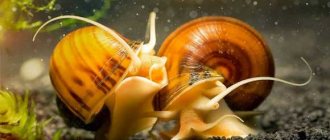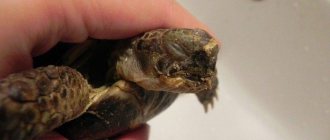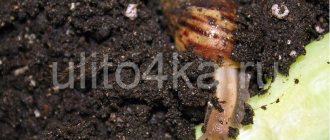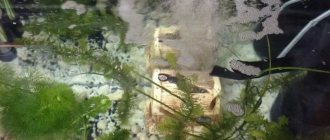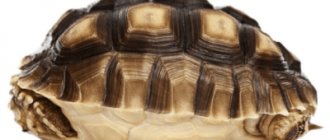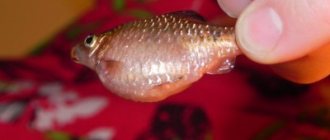With the onset of cold weather, some snail breeders are faced with one of the unusual conditions of the Achatina snail
- long sleep;
- hibernation;
- leaving her behind the turn.
Let's consider each of these conditions, the reasons for their occurrence and the removal of the Achatina snail from hibernation, as well as many other issues.
Reasons for prolonged sleep
One of the possible reasons for active preparation for hibernation is a decrease in air temperature. This factor has an adverse effect on the mollusk, so the slightest discomfort increases the likelihood that the snail will fall asleep for a long time.
An equally important factor in long sleep is getting used to a new habitat, which contributes to the emergence of a stressful situation. In order to somehow ensure a calm environment, the snail’s body is placed as deep as possible in the shell, the entrance of which is covered with a mixture of mucus, protein and other substances. A securely closed entrance to the mollusk's shelter guarantees its quiet and uninterrupted sleep.
Insufficient humidity in the environment also causes premature bedtime. Timely compliance with this step means that the snail will retain the maximum amount of moisture in the body, which is vital for its full functioning.
A long stay in a state of hibernation can also be facilitated by other unfavorable factors, including various types of poisoning, damage and disease. In such cases, you should pay close attention to your pet and ensure complete rest for full recuperation.
Going to sleep and waking up
Sleep is just a certain reaction of the body to harmful environmental conditions. At a normal level of humidity and optimal temperature, the snail can remain awake for quite a long time.
It is not recommended to put your pet into a sleepy state using artificial methods, otherwise it will affect development. Indeed, during hibernation, not only all metabolic processes in the body slow down, but also growth. This method should be used extremely rarely.
If the snail is in a deep state of rest, it is recommended to water it with warm boiled water for several minutes. Then you need to place the pet in conditions favorable to it.
After some time, a hungry snail will appear in the world, which must be provided with healthy and satisfying food. It’s hard to imagine what kind of appetite a sleep lover who has been in the kingdom of Morpheus for such a long period will develop!
Snail hibernation
Snails as pets are gaining more and more fans. Someone gets these creatures out of curiosity, and then gets so involved in caring for them that they cannot imagine their life without Achatina. Someone consciously decides to take this step. In any case, in order for your snail to feel comfortable next to you, and for you not to be tormented by remorse that you were the cause of its illness (more about snail diseases), we invite you to find out interesting information about these pets on the pages of our website .
And today we will talk about hibernation in snails. Why do these creatures need sleep, how long can it last, how to put a snail into hibernation and how to wake it up? We will try to answer these questions in our publication today...
Circadian rhythm
Circadian rhythms are physical, mental and behavioral changes that occur over a 24-hour period. Why 24 hours? Because that’s how long an earthly day lasts. Circadian rhythms respond to light and darkness in the body's environment. The sleep-wake cycle is a great example of this cycle. Animals, including humans, sleep at night and are awake during the day. This dream pattern roughly matches that of the sun.
All organisms have a biological clock. These are their innate temporary devices. The biological clock is made up of certain molecules; especially proteins that interact in cells throughout the body. Biological clocks are present in almost all tissues and organs. The biological clock produces circadian rhythms. They also regulate the synchronization of circadian rhythms.
So what does this have to do with sleeping snails? Because we follow a 24-hour day cycle, we often think that all animals follow the same cycle. Snails do not follow a 24-hour cycle. They sleep for hours on and off. And then they spend up to 30 hours without sleep. Let's talk about sleep.
Do snails hibernate?
It will be useful for new snail breeders to know that their pets can hibernate. While in it, they completely retract their body deep into the shell, and the entrance of the shell (called the mouth) is sealed with a special adhesive substance. This protective film, which experts call epiphragm, is formed with the help of mucus, grains of lime, which are produced by the sebaceous glands of snails, and protein substances. When hardened, such a film reliably seals the shell and guarantees the snail that its peace will not be disturbed.
It is noteworthy that if a snail’s sleep lasts for a long time, then it can form not one, but several epiphragms. However, with each such protective layer in the mouth area, the chances that you will be able to wake the snail become less. Therefore, it is better not to allow such a long sleep and make sure that your Achatina does not turn into a sleeping beauty or a handsome man.
Additional Resources
- https://www.ncbi.nlm.nih.gov/pubmed/21307060
- https://www.snail-world.com/where-do-snails-live/
- https://animals.mom.me/sleeping-habits-snails-6519.html
- https://news.nationalgeographic.com/2015/03/150310-snails-reproduction-sex-animals-science-evolution/
- https://www.sciencekids.co.nz/sciencefacts/animals/snail.html
- https://www.justushealthyeatingnigeriandiets.com/Health-benefits-of-snails.html
- https://wonderopolis.org/wonder/how-are-slugs-and-snails-different
- https://www.diffen.com/difference/Slug_vs_Snail
- https://www.snail-world.com/snail-anatomy/
- https://www.slugoff.co.uk/slug-facts/facts
The information on this website is not intended to replace personal contact with a qualified health care professional and is not intended to be used as medical advice. Please read our full medical disclaimer.
Psst...the sleep review industry is full of liars, sharks and thieves. It's the modern version of getting ripped off at your local mattress store. So why should you trust us?
How to put a snail into hibernation
As you can see, almost all the reasons explaining the snail’s sleep are associated with discomfort and unpleasant sensations for Achatina. As such, the snail does not need sleep - this is a protective mechanism of its body, which Nature invented for it. Therefore, experts still do not recommend specifically putting the snail into a state of sleep. And, although during hibernation all processes in Achatina’s body slow down, it loses a lot of strength, and there is always a risk that you may not wake up the snail. Therefore, unless absolutely necessary, you should not put the snail into hibernation. You must be aware of all the possible risks associated with such a dream. In addition, if we are talking about putting young snails to sleep, then you must understand that while at rest, the snails stop growing, so when they wake up, they will be smaller than their peers who did not sleep.
However, if you still need your Achatina to fall asleep - for example, you are leaving for several weeks, and there will be no one to look after your pet (although you can use the services of a pet hotel), you can artificially induce a state of hibernation in the snail ... To do this, transplant it into an ulitaria, where the soil is absolutely dry, stop feeding it and do not moisten it with water. In the room itself where the utilitarian is located, there must be a stable temperature and a stable level of humidity. Once in such an anti-comfortable environment, the snail will be forced to fall asleep in order to survive. However, it is not recommended to extend such sleep for a period longer than 1.5-2 months. Otherwise, Achatina may die, or you may not wake it up.
Reproduction
Achatina are hermaphrodites. Therefore, two snails are enough for a strong and healthy snail family.
Individuals usually lay a clutch of 200-300 eggs 5-6 times a year. The eggs take about two weeks to develop. At this time, it is better not to touch or clean the aquarium again, so as not to disturb the masonry.
Newborn snails first feed on the shells of their own eggs, and then switch to food. Young Achatina grow very quickly and reach impressive sizes within a year. Then growth gradually slows down, but gradually continues throughout life. And Achatina lives on average 7-10 years. Giant snails are not picky, but quite exotic pets.
Hello! I want to tell you about my pets, Achatina snails (two standard snails). Care is easy, they grow quickly, it’s interesting to watch them. Achatina mucus is not nasty, don’t be afraid!
I got them in March of this year, a woman gave me snails for free, I took two. Achatina are hermaphrodites, they have both female and male genital organs, so that a snail living alone can lay eggs, but this happens quite rarely. Then I wanted the smaller snail to be a boy, his name is Raoul, and the larger one to be a girl, his name is Aqua. In the photo with the little snail, they are a month old, but now they are already about four months old.
1. Each snail needs 10 liters, but I both feel great in 15 liters. You can use either a plastic or glass terrarium. There must be holes for air in it. In a glass terrarium, gauze cannot serve as a lid, the snails can chew through it and crawl away. There should be no stones where the snail lives! It can fall from the lid and break.
2. Soil - only coconut substrate, no garden soil, sand, soil from the street! You can buy it at a pet store (I bought 1 liter for 14 hryvnia (about 100 rubles)). The substrate needs to be poured with boiling water several times and washed under water, until the water flowing from under it becomes clear, then dry it.
3. You need to spray the terrarium once every two days, but not to the point of a swamp!
4. Achatina CANNOT be bathed under the tap.
1) They may choke.
2) bathing is stressful for them.
3) Chlorinated water forms a coating on the shell.
You can pour some water at room temperature into a bowl and put the snails there.
5. There are many foods that you can feed Achatina: a variety of fruits and vegetables, greens
For example: lettuce, cucumber, zucchini, carrots, banana, watermelon, apple, pear, dill, parsley, etc.
Mine love lettuce and zucchini)))
You can’t feed snails the same thing often; they will get used to it and refuse other food.
Snails cannot eat salty, sour, spicy, meat, citrus fruits, or kiwi. The nutrition table can be found on the Internet.
The snails' diet must contain calcium for shell growth, (crushed egg shells, sepia (cuttlefish shell) can be bought in pet stores and protein bait such as gammarus or daphnia.
Achatina needs to be fed once a day.
In my photo of the terrarium there is a small bowl of water, the red lid contains calcium, the blue lid contains gammarus, the white piece of something))) is sepia. From food - sweet pepper, lettuce, some green stuff, zucchini slices. If snails don't eat calcium just like that, sprinkle it on their food.
6. Snails have a shell growth zone - growth (yellow stripe), you can’t touch it with your hands, it can break, I’ve already had this situation.
7. It is not recommended to simply disturb snails (take them out of the terrarium), but it is possible (occasionally). You cannot pick up or pull snails by the shell, they may fall out of it! How to do this correctly can also be found on the Internet.
8. You can’t leave snails alone outside the terrarium; they can crawl away and you won’t find them later.
9. Many people write that you can safely leave for a week or two and leave the snail alone, it will simply “cover itself with film and sleep,” then you can wake it up by wetting it with water. This state of “being covered with a film” is called going into a curl. This is harmful for the snail and it is better that this does not happen. When leaving somewhere, give it to friends (for a while) or find a paid (possibly free) foster care.
If the snail still curls up, try to wet it with warm water and wait, then feed it well. in this state, Achatina loses a lot of weight.
10. I would like to say that, contrary to some opinions, snails see, but poorly, and they also have teeth, but in the form of a grater.
11. I haven’t tried cosmetic procedures using snails, so I won’t write anything about it.
12. My snails are not yet sexually mature, so they haven’t laid eggs and I’m not well versed in this topic.
This is probably all I wanted to tell))) I love my snails very much and I want all other snail owners to be healthy and happy!!! Thank you for your attention!!!
Every person, having a pet, must understand that the animal will die after some time from old age, illness or something else. We discussed in detail why snails die in. But today we’ll talk about how snails die and how to understand that a snail has died.
How to wake up a snail
In order to wake up a snail after a long sleep, it must be held under running warm water. However, given that the tap water is chlorinated, and chlorine elements can negatively affect the structure of the Achatina shell, we would recommend that you use boiled water and simply pour it over the Achatina. It will take 2-5 minutes (depending on the thickness of the protective layer and the number of such layers) for the snail to “break open” its door and emerge into the world.
We would call the following option a less stressful option for waking up. Place your pet in an ulitaria, with normal temperature conditions and humidity comfortable for the snail to live. Spray her with water and be patient to wait for her to wake up. A few hours later, the snail, making sure that its body has everything it needs, will emerge from its shell.
During its sleep, the snail will become very hungry, so provide it with an enhanced diet.
Video about the awakening of the Achatina snail after hibernation
Today we talked about whether snails sleep, what happens to them during such hibernation, how to put Achatina to sleep and how to wake it up. We'd love to hear your stories and opinions on whether snails should be hibernated. We look forward to your comments and, of course, photos of your snails.
We are waiting for your feedback and comments, join our VKontakte group!
Hibernation of snails and why they sleep
Snails are amazing creatures that occupy almost all habitat niches in nature. There is a very wide variety of species. In 2004, French scientists described only 80,000 species, and these are the most common, and many of them remain unknown to science.
Snails belong to the gastropod mollusks of the pulmonate order. Since they are cold-blooded creatures, they cannot regulate heat exchange in their body. Only by adapting to the time of day and seasons do they find the opportunity to survive for many years. They hibernate, slowing their vital signs, in anticipation of warmer days. The state of suspended animation also helps to prolong their life. They hide deep underground, where predators cannot reach them. For example, in the wild the grape snail lives up to three years, in captivity up to 7, and as pets there are even cases of special longevity up to 20 years. These aspects are determined by the influence of the environment, predators and parasites on them.
Feeding
Feeding Achatina is not difficult. They know very well what is useful for them and what is not. So it is impossible to poison them. The only thing that is strictly contraindicated for Achatina is salt and spices. So you should not feed your snails salty, peppery, hot or spicy foods.
In nature, young snails feed on stems and leaves, while old snails prefer slightly rotten plants. In captivity, snails are usually fed fruits, vegetables, grass and leaves.
The size of the food should be comparable to the size of the snails. And if an adult Achatina can easily eat a cucumber core, then a small snail can suffocate by burying itself in an excessively large piece of banana.
Food should be alternated. If you constantly give only, for example, cucumbers, the snail will get used to them and refuse to eat anything else.
For a snail to grow big and beautiful, it needs calcium. The shell serves not only as protection, but also as a kind of skeleton - all the internal organs of the snail are attached to it. But there will be no beautiful and large shell with a lack of calcium. Therefore, Achatina is mixed into food or special additives, or crushed shells from raw eggs. You can even simply lay the shell on the ground - the snails will find it and eat it themselves.
Since Achatina grows all its life, they need calcium all their lives. By the way, the color of snails depends on what they eat. So the snail owner has a chance to grow his own.
No need to worry about water. Snails lick moisture from the walls of the house. That's why it's so important to spray them with water several times a day.
What do snails do at night and how much do they sleep per day?
Land mollusks, like aquatic mollusks, are mainly nocturnal in the warm season. When everyone is awake, they sleep, hiding in the shade of tall grass, under stones and leaves, waiting for darkness to fall. As soon as the scorching sun disappears below the horizon and the humidity level rises, the snails crawl out of their shelter to begin their nightly feast and stock up on essential nutrients for the winter. It will last until the morning dew and the first rays of sunshine appear.
Snails are quite voracious creatures and have about 25,000 teeth located on their tongue. With their help, they cut and grind food. In large flocks, mollusks are capable of destroying more than one hectare of vineyards and other greenery that gets in their way. The duration of the meal reaches three hours. In the warm season, they live a full life, reproduce and eat a lot. Before the onset of cold weather, a new generation grows up and manages to get stronger.
Hibernation of grape snails
With the onset of the cold season, snails hibernate, a state of suspended animation. During this period, all processes slow down, including metabolism and even heartbeat. The average duration of hibernation is from 4 to 6 months. This period usually starts from mid-October to early November. As soon as the air temperature begins to drop below 12-15 degrees. The vine snail usually burrows into the ground to a depth of 30 centimeters and seals its house with a plug made of limestone stored over the summer. This species does not tolerate freezing temperatures very well. For example, Helix Aspersa also hibernates with decreasing day length and colder weather, but the houses of this species are more resistant to low temperatures and are capable of preventing freezing of the mollusk’s body tissues.
The survival ability of this mollusk is also increased due to the presence of certain characteristics:
- reduction in water mass,
- epiphragm formation
- relatively large sizes,
- shell shape and shell.
For warmer climates, where there is no sub-zero temperature, this of course does not matter much, but for a more aggressive environment such characteristics are very important.
How long and how do snails sleep?
Depending on the climate in which the mollusk is located, the period of suspended animation can last about six months, until the onset of favorable weather conditions. Snails can fall into this state not only from cold weather, but also from drought and lack of moisture. As soon as conditions change for the better, the mollusks wake up and begin to lead an active lifestyle. After waking up, they are very hungry and therefore eat all the greenery that is in their field of vision.
On specialized farms in artificial conditions, it is necessary to monitor the temperature and humidity levels. Often, an unexpected increase in temperature entails premature awakening of mollusks, and as a result, their death or infertility.
Under artificial conditions, before hibernation, mollusks are placed in dry cardboard boxes or on pallets, where for a week they empty their intestines and get rid of excess moisture. This is the so-called drying period. After this, they are placed in wicker bags, then in plastic boxes, in order to avoid damage from excess pressure. When the shellfish are “packed,” they are sent to special storage facilities, where the required level of moisture and cold is maintained. The temperature should be lowered gradually by 1-2 degrees per day. Very low temperatures should also be avoided to prevent crystallization.
General provisions
Most snails in captivity do not live long, since their life expectancy depends on the conditions of detention, diet and diseases suffered by them.
The land snail Achatina, the most common domestic gastropod, for example, begins to age at about 4-5 years. The shell of the mollusk turns white, appetite and general activity deteriorate. All this is often accompanied by various diseases, which can cause the death of a gastropod. It is not always possible to detect a diseased snail in advance and begin treatment. There are often situations in which yesterday the mollusk was active and healthy, but today it has gone beyond the turn and shows no signs of life. Such cases are very rare and are mostly caused by genetic diseases.
In other cases, snail owners see the suffering of their pets, but cannot do anything. The pet dies within a few days, or even weeks. If all else fails, it would be more humane to help it die so that the animal does not suffer, by placing the sick mollusk in the freezer.
How to bring snails out of hibernation
You need to wake up the mollusks very carefully and carefully, since sudden changes in the conditions around them can put them in a stressful state and lead to death. To awaken the mollusks and avoid large losses, increase the air temperature gradually by several degrees per day, simulating natural warming. This will help avoid stress. You can speed up this process a little by watering your pets with warm water. They will gradually feel warm and begin to emerge from their shells. Don't forget that the snails haven't eaten all winter. Usually, after wintering, they are placed in special feeders, where they are watered and food is laid out on shelves. When they wake up, they will instinctively find him. When everyone wakes up, they can be transferred to natural habitats, where over the summer they will again replenish the necessary nutrients for the next wintering.
Treatment
Sometimes it is recommended to use metronidazole or trichopolum. These are antibiotics and can be bought at any pharmacy.
For an adult, you need to use 1/8 of a tablet, and in especially severe cases, 1⁄4 of a tablet per 700 milliliters of warm boiled water. For young individuals, a lower dosage is used. You need to bathe your pet for about 10 minutes, 1-2 times a day, preferably in the evening at the same time. The pet must first be soaked in warm water if it is behind a coil.
The main point of this procedure is for the snail to crawl and drink the medicine. The course of treatment must be at least 10 days. When using these or similar drugs, keep in mind that you are dealing with an antibiotic, and there is a risk of side effects. For example, there is an opinion that treatment with these drugs leads to the cessation of the ability of snails to reproduce.
It is very important not to interrupt the course of treatment, even if the condition of the cochlea seems to improve. If she gets sick again, the drug you treated your pet with will no longer help, and stronger antibiotics will have to be used.
In very advanced cases, use the following:
- Ciprofloxacin 1/8 tablet per 0.7 liter of warm water. The course of treatment is 10 days.
- Metronidazole and ciprofloxacin, 1/8 tablet per 0.7-1 liter of warm boiled water. The course is also 10 days.
If, despite your efforts, the mollusk goes deeper behind the coil, its body hardens, and liquid appears in the shell, then the snail dies. And if the “aroma” of rotten fish is added to all of the above, then from this we can understand that the snail has died.


